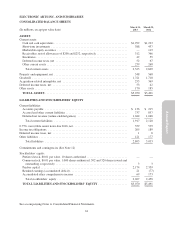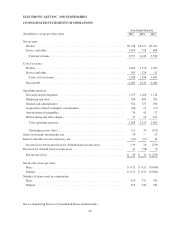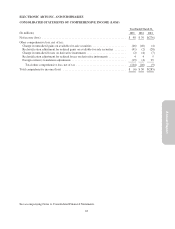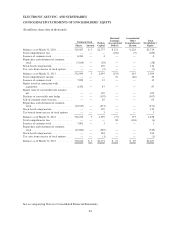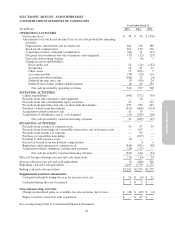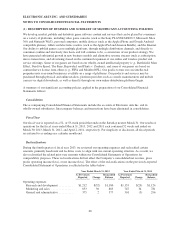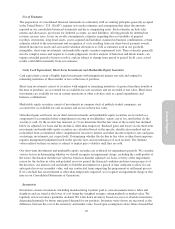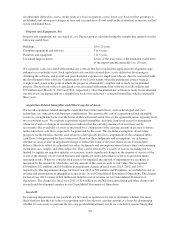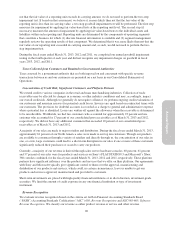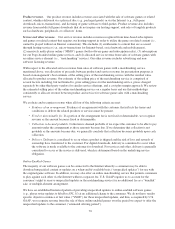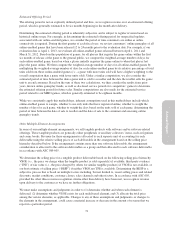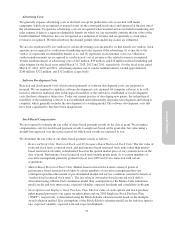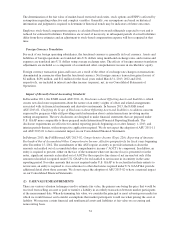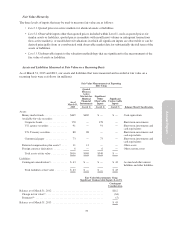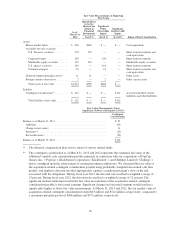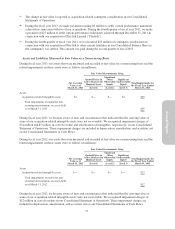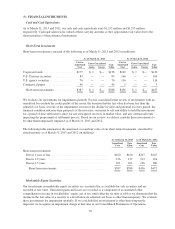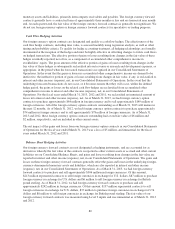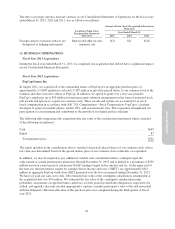Electronic Arts 2013 Annual Report Download - page 155
Download and view the complete annual report
Please find page 155 of the 2013 Electronic Arts annual report below. You can navigate through the pages in the report by either clicking on the pages listed below, or by using the keyword search tool below to find specific information within the annual report.
Annual Report
Estimated Offering Period
The offering period is not an explicitly defined period and thus, we recognize revenue over an estimated offering
period, which is generally estimated to be six months beginning in the month after delivery.
Determining the estimated offering period is inherently subjective and is subject to regular revision based on
historical online usage. For example, in determining the estimated offering period for unspecified updates
associated with our online-enabled games, we consider the period of time consumers are online as online
connectivity is required. During the first quarter of each fiscal year, we review consumers’ online gameplay of all
online-enabled games that have been released 12 to 24 months prior to the evaluation date. For example, if our
evaluation date is April 1, 2013, we evaluate all online-enabled games released between April 1, 2011 and
March 31, 2012. Based on this population of games, for all players that register the game online within the first
six months of release of the game to the general public, we compute the weighted-average number of days for
each online-enabled game, based on when a player initially registers the game online to when that player last
plays the game online. We then compute the weighted-average number of days for all online-enabled games by
multiplying the weighted-average number of days for each online-enabled game by its relative percentage of total
units sold from these online-enabled games (i.e., a game with more units sold will have a higher weighting to the
overall computation than a game with fewer units sold). Under a similar computation, we also consider the
estimated period of time between the date a game unit is sold to a reseller and the date the reseller sells the game
unit to an end consumer. Based on the sum of these two calculations, we then consider the results from prior
years, known online gameplay trends, as well as disclosed service periods for competitors’ games to determine
the estimated offering period for future sales. Similar computations are also made for the estimated service
period related to our MMO games, which is generally estimated to be eighteen months.
While we consistently apply this methodology, inherent assumptions used in this methodology include which
online-enabled games to sample, whether to use only units that have registered online, whether to weight the
number of days for each game, whether to weight the days based on the units sold of each game, determining the
period of time between the date of sale to reseller and the date of sale to the consumer and assessing online
gameplay trends.
Other Multiple-Element Arrangements
In some of our multiple element arrangements, we sell tangible products with software and/or software-related
offerings. These tangible products are generally either peripherals or ancillary collectors’ items, such as figurines
and comic books. Revenue for these arrangements is allocated to each separate unit of accounting for each
deliverable using the relative selling prices of each deliverable in the arrangement based on the selling price
hierarchy described below. If the arrangement contains more than one software deliverable, the arrangement
consideration is allocated to the software deliverables as a group and then allocated to each software deliverable
in accordance with ASC 985-605.
We determine the selling price for a tangible product deliverable based on the following selling price hierarchy:
VSOE (i.e., the price we charge when the tangible product is sold separately) if available, third-party evidence
(“TPE”) of fair value (i.e., the price charged by others for similar tangible products) if VSOE is not available, or
our best estimate of selling price (“BESP”) if neither VSOE nor TPE is available. Determining the BESP is a
subjective process that is based on multiple factors including, but not limited to, recent selling prices and related
discounts, market conditions, customer classes, sales channels and other factors. In accordance with ASC 605,
provided the other three revenue recognition criteria other than delivery have been met, we recognize revenue
upon delivery to the customer as we have no further obligations.
We must make assumptions and judgments in order to (1) determine whether and when each element is
delivered, (2) determine whether VSOE exists for each undelivered element, and (3) allocate the total price
among the various elements, as applicable. Changes to any of these assumptions and judgments, or changes to
the elements in the arrangement, could cause a material increase or decrease in the amount of revenue that we
report in a particular period.
71


